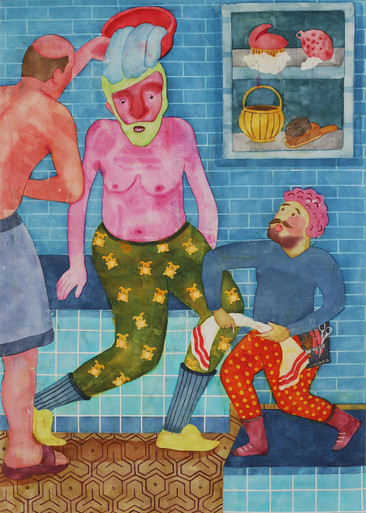ORKIDEH TORABI
SPOTLIGHT:
ORKIDEH TORABI
The Chicago-based artist muses on her creative process and the power of childhood influences.
Do you remember the first thing you drew as a child?
I think one of my first paintings was of my grandparents. When I was little, I spent a lot of time with them, especially my grandparents on my mother’s side. They had a big dining table and I would sit there and paint them with their little dog which was black and had fluffy fur. My grandma always hung my paintings on the wall and it was very encouraging. I think she still has some of them.
Were you fascinated by color as a child, or by a particular color? Do you remember the first moment you realized that you see the world in images?
My interest in bright colors comes from comic strip books. When I was a kid, I loved reading comic strips and looking at their images. I had all of the Tin-Tin comics in Farsi. I read them hundreds of times. I also borrowed comic books from my friends. I loved the bright colors and the funny texts. Purple was my favorite color. I always asked my dad to buy a purple car and he would laugh. I don’t remember a time that I didn’t see the world in images!
What would you say most surprises people about your personality?
I think generally people find me funny and sometimes clumsy. Other times, they might get confused or find me too serious. I have an absurd, ironic sense of humor. Over time, I think this paradox has been translated into my work: layers of fun, seriousness, confusion, humor – the list goes on.
Where did you first encounter Persian miniatures and how did they come to influence your work?
Persian miniatures were always accessible to me in Iran, but, when I was younger, my interest and curiosity gravitated toward Western painting. I didn't understand miniatures very well until I started doing research. I spent five years researching Persian miniatures, and over the course of that time, I became really impressed by them. They had a huge impact on me. I started to appreciate these images more than before and I started having a better understanding of them. For instance, there is no perspective in Persian miniatures, or we could say these images have their own kind of perspective. Everything in the image seems flat, but showing the exterior and interior of a space simultaneously gives depth to the image. As a result, they began to appear in my work in the form of symbolic shapes and lines. My mom sometimes told me stories from the Shahnameh at bedtime which originally contains some miniatures. The part about Rostam fighting with the White Demon was my favorite. There is a part where the White Demon not only lifts Rostam up but lifts him up with his surroundings.
You Made it is one of my favorite pieces of yours. On a more personal note, the pumpkins struck me immediately. When I first migrated to the United States, I wore a Halloween T-shirt with pumpkins on it to school on random days. I had no idea about Halloween! I don’t think I cared even after I found out it was a one-day-a-year event. I kept wearing that shirt because I liked it. You Made It seems to capture the absurdity of the American Dream and the very idea of ‘making it.’ It is poking fun at the idea of assimilation and arrival. Was that on your mind as you were painting? And what do you think the angel is whispering into the protagonist’s ear?
The angel is whispering the painting’s title into the protagonist’s ear. But the protagonist has no clue what the angel is talking about. About the pumpkins, you got it right. Also, in some of my paintings, I use fruits as symbols and play with their meanings. Pumpkins here could deliver this sense of sweetness and relief. They could also give you this sense of contrast where you don’t expect to see an angel in a pumpkin farm talking to this person about something he doesn’t even have any clue about: the idea of ‘making’ it or fulfilling one’s immigrant dreams.
Can you describe your process when creating these layered silkscreen pieces? Are you more of an outliner, or do you improvise?
I paint with dye on the screen and then transfer the image onto the fabric. I apply several layers to the fabric until I create the image I am looking for. There is a lot of chance to the placement of the images involved, which I love. This is conscious and plays a significant role in my use of print as a medium. About being an outliner or improviser, I consider myself being both. It depends on the painting I am working on. Sometimes, I plan it based on my sketches and sometimes I just play with layering. Usually, the painting is different from what I had in my mind in the beginning.
Do you ever have dreams about your paintings?
I don’t usually have dreams about my paintings at night but I pretty much dream about them all day long!
Do you have any hobbies you're really passionate about outside of making art?
I love watching animated movies at night. They are a source of inspiration for me. They give me ideas about my works. They also help me get distracted from work sometimes so I can go to sleep easier. I don’t think there are many animated movies that I haven’t seen at this point!



